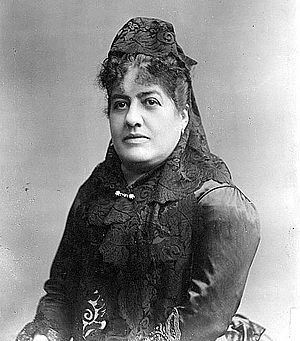Mercedes Cabello de Carbonera facts for kids
Mercedes Cabello Llosa de Carbonera (born in Moquegua, Peru, on February 7, 1845 – died in Lima, Peru, on October 12, 1909) was an important Peruvian writer. She was inspired by ideas like positivism (a way of thinking that focuses on science and facts) and naturalism (a style of writing that shows life as it really is). Mercedes Cabello helped start literary realism in Peruvian novels. This means her stories showed real-life situations and characters.
She wrote six novels that talked about society and criticized certain issues. Her most famous novels were Blanca Sol (1888), Las consecuencias (1890), and El conspirador (1892). She also wrote many articles and essays for Peruvian newspapers. These writings covered topics about literature and society. Mercedes Cabello strongly supported women's rights and was one of Peru's first feminists. She was a friend of Manuel González Prada, another writer who shared some of her ideas. She also attended special gatherings called tertulias hosted by Juana Manuela Gorriti. These meetings allowed her to meet other female writers and discuss literature and ideas about women's freedom.
In her novels like Sacrificio y recompensa, Blanca Sol, Las consecuencias, and El conspirador, a common theme is how women are shown. They often appear as "helpless" or "suffering." Another main topic in her writing was her criticism of the wealthy upper class in Lima during the 1860s and 1880s.
Contents
Friends and Connections
Mercedes Cabello de Carbonera is often linked with other Peruvian female writers. These include Carolina Freine de Jaimes and Juana Manuela Gorriti.
Mercedes Cabello used a secret name, or pseudonym, for some of her writings. Her pseudonym was Enriqueta Pradel. She used this name to publish her work in magazines like El Album and El Recreo.
Early Life and Education
Mercedes Cabello de Carbonera was born into a rich family in Moquegua. This allowed her to receive an education. The region of Moquegua, where she grew up, was affected by Chilean troops later on. This experience influenced her novel El Conspirador. During her childhood, Ramón Castilla was the president of Peru. His open-minded policies helped improve what women could learn in school. Subjects like French, English, geography, and arithmetic became available.
She learned French when she was young. This skill helped her read books by European writers without needing translations. Mercedes Cabello's education was not from regular schooling. Because there were few schools for girls, her parents hired private teachers. These tutors taught her subjects considered proper for young ladies from wealthy families. However, she mostly taught herself and loved to read. This allowed her to read many books that other Peruvians were not reading. European writing styles like Romanticism and Naturalism greatly influenced her work. These styles were important in 19th-century literature. Authors who could include romantic and naturalistic ideas in their books were highly praised.
Later Life and Career
When she was twenty-two, Mercedes Cabello de Carbonera moved to Lima. There, she married a doctor and began her writing career. She became a widow at a young age. This situation gave her more freedom than many women had. She did not have children, which also allowed her more independence. She understood that her position was unique. So, she wrote to encourage women to fight against unfair control by men.
Even as a widow, Mercedes Cabello became very active in the literary world. Her books were published and widely read during her lifetime. She became one of the first best-selling Peruvian writers. Her work was quite controversial in the 19th century. This was because she openly criticized the wealthy Peruvian upper class.
Views on Religion
Mercedes Cabello de Carbonera was not against Catholicism. However, she did criticize how some wealthy women used religious holidays. She felt they used these times to show off their expensive clothes. Her criticism was about how high society used religion, not about religion itself. She also believed that religion should not be the main focus of women's education. This was a common practice at the time.
In her writings, Mercedes Cabello de Carbonera showed a strong commitment to the social problems of her time. Her goal to highlight the issues of the wealthy class was clear in many of her novels. One problem she wanted to address was the lack of good education for women. She used ideas from positivism to convince liberal thinkers. These thinkers were open to improving education standards for women. We can see how limited women's education was in her novel Blanca Sol. The main character in this book has a poor education. She also lacks strong female role models to guide her away from old-fashioned social rules. Each of Mercedes Cabello de Carbonera's novels tells a story that reflects Peru's history.
Main Works
Novels
- Sacrificio y recompensa (Lima, 1886)
- Eleodora (Madrid, 1887) – later rewritten as Las consecuencias
- Los amores de Hortensia (1886 and 1887)
- Blanca Sol (novela social) (1888, 1889 and 1894)
- Las consecuencias (1890)
- El conspirador (autobiografía de un hombre público) (1892 and 1898)
Essays
- Influencia de las Bellas Letras en el progreso moral y material de los pueblos (1887)
- La novela realista
- La novela moderna (1892)
- Importancia de la literatura
- Estudio comparativo de la inteligencia y la belleza de la mujer
- Perfeccionamiento de la educación y la condición social de la mujer
- La religión de la humanidad (1893)
- El conde León Tolstoi (1894)
See also
 In Spanish: Mercedes Cabello de Carbonera para niños
In Spanish: Mercedes Cabello de Carbonera para niños


